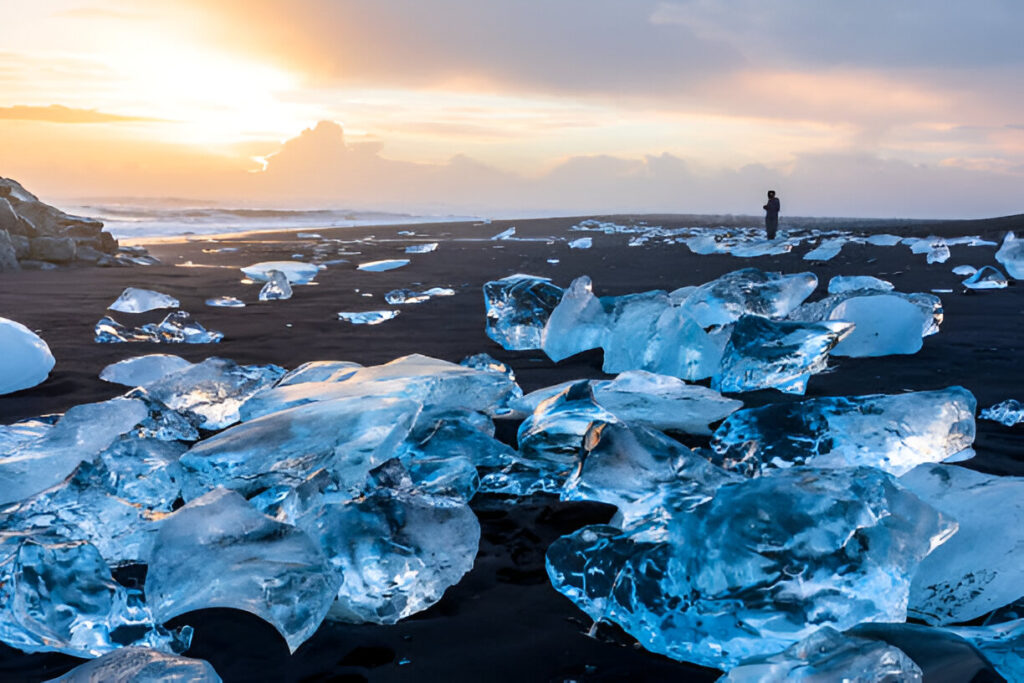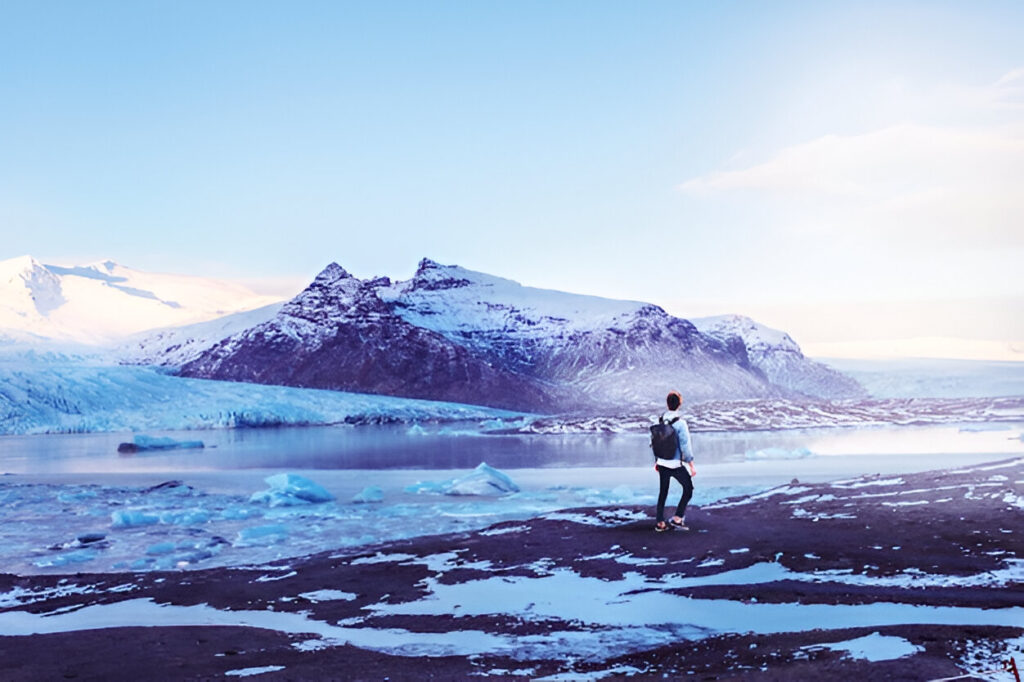Iceland is a land of breathtaking landscapes, dramatic natural wonders, and ever-changing weather. Choosing the best time to travel to Iceland depends on what you want to experience—whether it’s the magical Northern Lights, the endless summer daylight, or the serene winter landscapes. In this comprehensive guide, we’ll explore the pros and cons of each season, helping you decide the best time to travel to Iceland for your dream adventure. For more information visit here :

Spring (April to May)
Highlights:
- Wildlife Watching: Spring is an excellent time for birdwatching as migratory birds return, and puffins start nesting along the cliffs.
- Whale Watching: April marks the beginning of the whale watching season, with opportunities to see various species along the coast.
- Longer Days: Daylight increases significantly, providing ample time for sightseeing and outdoor activities.
Considerations:
- Variable Weather: Spring weather can be unpredictable, with a mix of snow and rain.
- Limited Access: Some highland roads and trails may still be closed due to snow.
Summer (June to August)
Highlights:
- Midnight Sun: Experience nearly 24 hours of daylight, allowing for extended exploration and unique photo opportunities.
- Outdoor Activities: Ideal conditions for hiking, camping, and road trips, especially in the highlands.
- Festivals: Summer hosts various cultural events and festivals, offering insights into Icelandic traditions.
Considerations:
- Peak Tourist Season: Expect larger crowds and higher prices for accommodations and tours.
- Limited Northern Lights: The extended daylight makes it difficult to see the aurora borealis during this period.
Autumn (September to October)
Highlights:
- Northern Lights Return: As nights grow longer, the chances of witnessing the aurora borealis increase.
- Fewer Tourists: Enjoy popular sites with fewer crowds compared to the summer months.
- Autumn Colors: The landscape transforms with vibrant fall foliage, offering picturesque views.
Considerations:
- Shorter Days: Daylight hours decrease, requiring more careful planning for activities.
- Variable Weather: Weather can be unpredictable, with increasing chances of rain and wind.
Winter (November to March)
Highlights:
- Northern Lights Viewing: Winter offers the best conditions for seeing the aurora borealis, especially in remote areas with clear skies.
- Ice Caves and Glaciers: Explore natural ice caves and enjoy glacier hikes, activities unique to the colder months.
- Festive Atmosphere: Experience Icelandic holiday traditions, including Christmas markets and New Year’s celebrations.
Considerations:
- Limited Daylight: Some days have as few as 4-5 hours of daylight, affecting the duration of outdoor activities.
- Challenging Weather: Be prepared for snowstorms and icy conditions, which can impact travel plans.
Choosing the Best Time to Travel to Iceland Based on Activities
When deciding on the best time to travel to Iceland, understanding the specific experiences and activities available in each season can help tailor your itinerary.
Northern Lights (Aurora Borealis)
One of Iceland’s most iconic natural phenomena is the Northern Lights. These swirling green and purple lights are most visible from late September to early April, when the skies are dark and the auroral activity is at its peak.
- Best time: Late September through March
- Recommended locations: Thingvellir National Park, East Fjords, and Westfjords
- Tips: Use aurora forecast tools and stay in areas with minimal light pollution.
Seeing the aurora borealis is often a once-in-a-lifetime experience and plays a major role in defining the best time to travel to Iceland for many tourists.
Midnight Sun and 24-Hour Daylight
If the Northern Lights are winter’s treasure, the Midnight Sun is summer’s crown jewel. From late May to mid-July, parts of Iceland experience continuous daylight. In the northern parts, the sun never fully sets.
- Best time: June (especially around the summer solstice on June 21)
- Perfect for: Hiking, photography, road trips, wildlife spotting
The Midnight Sun allows visitors to explore without time restrictions, making it a strong reason summer is considered the best time to travel to Iceland for adventure lovers.
Road Trips and Driving the Ring Road
Driving the famous Ring Road (Route 1) is a dream for many travelers. This 1,332-km road loops around Iceland, passing through waterfalls, glaciers, black sand beaches, volcanoes, and more.
- Best time: Late May through early September
- Why: Roads are mostly clear, weather is mild, and highland routes are open.
If you’re planning an extended road trip, summer is generally the best time to travel to Iceland, thanks to favorable driving conditions and long daylight hours.
Glacier Tours and Ice Caving
Iceland is home to Europe’s largest glacier—Vatnajökull—and a variety of breathtaking glacier formations. During the winter months, visitors can explore the blue ice caves that form naturally each year.
- Best time: Mid-November to mid-March
- Tour access: Guided tours only for safety reasons
- Popular locations: Vatnajökull National Park, Langjökull Glacier
These magical caves are one of the most photogenic sites in Iceland. For those looking to capture Instagram-worthy winter landscapes, this is the best time to travel to Iceland.
Festivals and Cultural Events
Many visitors want to experience Icelandic culture firsthand, and attending a festival is a great way to do that. Iceland hosts several well-known music, art, and food festivals across the year.
- Best time for festivals: Summer (June–August)
- Top events:
- Secret Solstice Festival (Reykjavík)
- Iceland Airwaves (November)
- National Day (June 17)
- Reykjavik Pride (August)
Whether you’re into live music, LGBTQ+ celebrations, or historical reenactments, summer is often the best time to travel to Iceland to soak in its rich cultural vibe.
Whale Watching Season
Iceland’s coastal waters are teeming with marine life, especially during the summer when food is abundant. The whale watching season runs from April to October, peaking in June and July.
- Best time: June and July
- Top spots: Húsavík, Reykjavík, Akureyri
- Species seen: Humpback whales, minke whales, orcas, and blue whales
If marine life fascinates you, aligning your trip with this season is a great way to determine the best time to travel to Iceland.
Weather Patterns and What to Expect
Summer Weather (June to August)
- Temperatures: 10°C to 15°C (50°F to 59°F)
- Conditions: Mostly dry, occasional rain
- Daylight: 20–24 hours
Ideal for hiking, camping, and photography. Many trails and F-roads (mountain roads) are open only during this time.
Winter Weather (November to March)
- Temperatures: -5°C to 3°C (23°F to 37°F)
- Conditions: Snowy, windy, occasional storms
- Daylight: 4–7 hours
Perfect for glacier activities, Northern Lights, and snowy landscapes. Just be prepared for travel delays due to weather.
Spring & Autumn
- Spring (April–May): Temperatures rise, melting snow reveals waterfalls and fresh greenery.
- Autumn (September–October): Vivid foliage, early chances of aurora, and fewer tourists.
Spring and autumn are often called “shoulder seasons,” and can be a great compromise when planning the best time to travel to Iceland.
Crowd Levels and Pricing
Understanding peak tourist seasons can help you plan your trip more efficiently and cost-effectively.
| Season | Crowd Level | Pricing | Best For |
|---|---|---|---|
| Summer | High | Expensive | Road trips, festivals, hiking |
| Winter | Moderate | Medium | Northern Lights, winter photography |
| Spring | Low | Budget-friendly | Wildlife watching, fewer tourists |
| Autumn | Low | Budget-friendly | Foliage, early aurora, quieter experiences |
So, if avoiding crowds and saving money is important to you, spring or autumn might be the best time to travel to Iceland.
Tips for Visiting Iceland at Any Time of Year
Regardless of when you visit, Iceland requires a bit of planning. Here are some general tips that apply year-round:
- Pack Layers: Weather can change quickly. Always bring waterproof and windproof outer layers.
- Book in Advance: Especially in summer, accommodations and tours fill up quickly.
- Rent a 4×4 Vehicle: In winter or if traveling to the highlands, a four-wheel-drive vehicle is essential.
- Respect Nature: Stay on marked paths, don’t disturb wildlife, and follow local guidelines.
- Use Travel Apps: Download weather, aurora forecast, and road condition apps to stay informed.
Summary: What’s the Best Time to Travel to Iceland?
There is no universal answer to the best time to travel to Iceland, because it depends entirely on what you’re looking for. Here’s a simplified breakdown:
| Preference | Best Time |
|---|---|
| See Northern Lights | November to March |
| Explore with 24-hour daylight | June |
| Drive the Ring Road | June to August |
| Visit Ice Caves | November to March |
| Go Whale Watching | April to October (peak: June–July) |
| Avoid Crowds and Save Money | April–May or September–October |
Each season brings something different, which is why many travelers return multiple times to explore Iceland under different conditions. Whether you’re seeking adventure, relaxation, or natural wonder, you’ll find that there’s always a best time to travel to Iceland—it just depends on your priorities.
Monthly Breakdown: Best Time to Travel to Iceland, Month by Month
Let’s take a closer look at Iceland, month by month, to better determine the best time to travel to Iceland based on specific seasonal changes, festivals, weather, and daylight.
January
- Highlights: Prime time for the Northern Lights and ice cave exploration.
- Weather: Coldest month; average temperatures range from -1°C to -5°C (30°F to 23°F).
- Daylight: 4–7 hours.
January is the best time to travel to Iceland if your focus is winter photography, snowy adventures, and aurora hunting. It’s a quiet, magical time.
February
- Highlights: Continuation of aurora season, snowmobiling, and glacier hiking.
- Weather: Cold, with heavy snow in many areas.
- Daylight: Increases to about 7–10 hours.
February is excellent for winter sports lovers and those seeking solitude. It’s also one of the most photogenic months.
March
- Highlights: End of winter activities, better daylight, and still a good chance to see the Northern Lights.
- Weather: Cold but improving.
- Daylight: 10–13 hours.
March is a transitional month. It’s still wintery but becoming more accessible. For a mix of activities, this could be the best time to travel to Iceland.
April
- Highlights: Puffins begin to return, whale watching starts, and roads become easier to navigate.
- Weather: Warming up, but still chilly.
- Daylight: 13–16 hours.
April marks the start of spring. It’s a great time for budget-conscious travelers looking to beat the summer rush.
May
- Highlights: Blooming landscapes, open roads, and increased wildlife sightings.
- Weather: Mild, with pleasant temperatures.
- Daylight: 16–20 hours.
May offers great value, fewer tourists, and near-summer experiences. It’s often called a hidden gem month — truly one of the best times to travel to Iceland.
June
- Highlights: Midnight Sun, festivals, fully accessible roads and highlands.
- Weather: Warmest of the year.
- Daylight: Up to 24 hours.
June is ideal for outdoor lovers and festivalgoers. The sheer amount of daylight makes it a top contender for the best time to travel to Iceland.
July
- Highlights: Peak of tourist season, green landscapes, excellent hiking conditions.
- Weather: Comfortable, around 10–15°C (50–59°F).
- Daylight: Around 20–22 hours.
July offers Iceland at its fullest — lush, active, and vibrant. Great for family travel and first-time visitors.
August
- Highlights: Last month of summer warmth, berry picking, and early chances of aurora.
- Weather: Still warm and pleasant.
- Daylight: 16–20 hours.
August blends the best of summer with early autumn. For those who want a balanced experience, this may be the best time to travel to Iceland.
September
- Highlights: Fall colors, fewer crowds, and good Northern Lights visibility.
- Weather: Cooling down but manageable.
- Daylight: 12–14 hours.
September is ideal for photographers and travelers who want a more relaxed pace. It’s budget-friendly and visually stunning.
October
- Highlights: Aurora activity increases, autumn peaks, and ice caves begin opening.
- Weather: Unpredictable but exciting.
- Daylight: 9–11 hours.
October is moody, beautiful, and less crowded. A fantastic time for adventure seekers looking for the edge of winter experiences.
November
- Highlights: Start of winter season, prime for auroras and low-season pricing.
- Weather: Cold and dark, especially late November.
- Daylight: 4–8 hours.
November is a great budget month, with early snow and minimal tourism. Just be ready for the chill.
December
- Highlights: Christmas and New Year festivities, peak Northern Lights season.
- Weather: Cold and festive.
- Daylight: Shortest of the year (4–5 hours).
For magical holidays, December is possibly the best time to travel to Iceland, especially if you’re chasing festive vibes and winter beauty.

Best Time to Travel to Iceland Based on Traveler Type
Not every traveler is the same. Here’s how to choose the best time to travel to Iceland depending on your style and priorities.
1. Photographers
- Best Time: Winter (for aurora and snow landscapes) & Autumn (for foliage)
- Why: Soft light, fewer tourists, and dramatic scenery
2. Adventure Travelers
- Best Time: Summer (June–August)
- Why: Access to hiking trails, F-roads, and warm weather
3. Budget Travelers
- Best Time: Spring and Autumn (April–May, September–October)
- Why: Lower prices, fewer crowds, decent weather
4. Nature Lovers
- Best Time: Summer and Early Autumn
- Why: Puffins, whales, wildflowers, and vibrant landscapes
5. First-Time Visitors
- Best Time: June or September
- Why: Balanced weather, long days, fewer surprises
Common Mistakes to Avoid When Planning Your Trip
Even when choosing the best time to travel to Iceland, there are a few common errors to watch out for:
- Underestimating Weather: Always check road and weather conditions. Iceland’s climate changes quickly.
- Overpacking Activities: Factor in driving time and weather delays.
- Skipping Insurance: Travel and car insurance are essential.
- Neglecting Off-Season Perks: Winter trips are just as rewarding.
- Only Visiting the Golden Circle: Explore beyond popular routes to see true Icelandic beauty.
Frequently Asked Questions
Is summer really the best time to travel to Iceland?
It’s certainly the most popular due to long days, good weather, and open roads. However, it depends on your goals — some prefer winter’s magical light and solitude.
Can I see the Northern Lights in summer?
No, summer nights are too bright. The best time to see the Northern Lights is between September and April, especially in the darkest winter months.
Is Iceland very expensive to visit?
Iceland can be pricey, but visiting in the shoulder seasons (spring or autumn) can help reduce costs on flights, hotels, and car rentals.
What month has the best weather in Iceland?
June and July offer the best weather in terms of sunshine and warmth, making it the best time to travel to Iceland for those who want to explore comfortably.
Is it worth visiting in winter?
Absolutely. If you’re interested in the Northern Lights, glacier tours, or fewer tourists, winter could easily be the best time to travel to Iceland for you.
Final Thoughts
Iceland is a land of dramatic contrasts — fire and ice, midnight sun and pitch-black nights, bustling festivals and serene solitude. Every season brings something truly special. Whether you’re drawn by glowing auroras or endless daylight, there is no wrong choice. The best time to travel to Iceland depends on what you want to experience, and the great news is — Iceland never disappoints.





